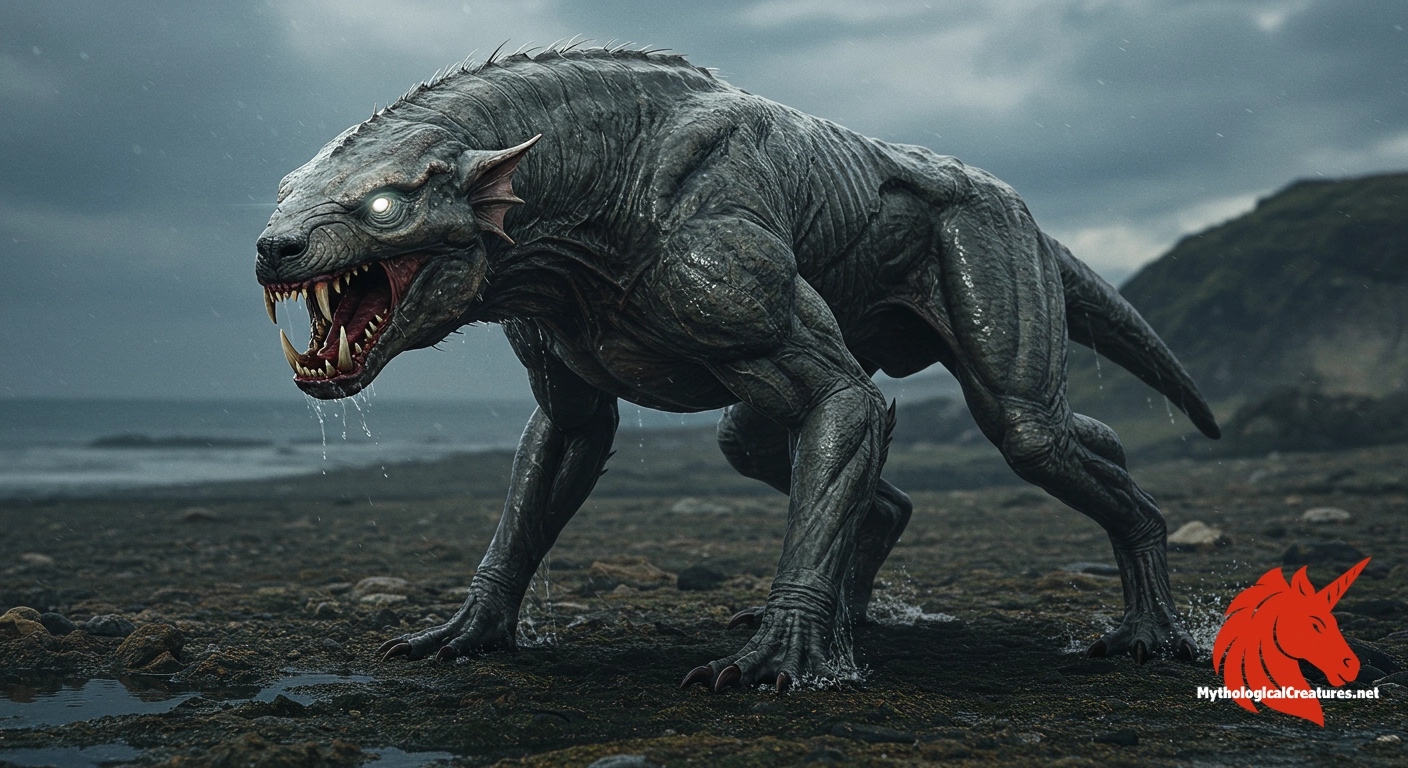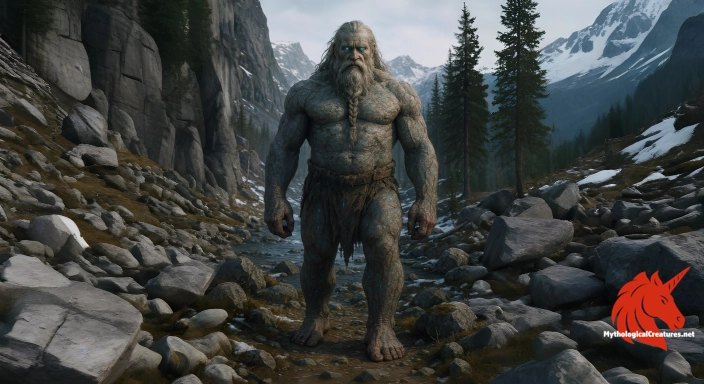Onchú: The Onchú is a mythical, venomous canine from Irish legend.

Onchú
Onchú - The Onchú embodies a fearsome and venomous presence in Irish mythology and has significantly influenced heraldic symbolism.
Origins & First Encounters
The onchú emerges from the mists of early Irish myth as a creature both feared and revered in ancient tradition. Its origins appear intertwined with the turbulent history and rich oral storytelling of medieval Ireland. Early records, including those composed in the 12th century, frame the onchú as one of the venomous beasts that haunted the landscapes between significant bodies of water. Its first attestation in epic accounts sets the stage for a legendary creature whose presence transcended mere animality to embody chaos and wild natural forces. Embedded within a cultural context of heroic battles and supernatural omens, the onchú was both a symbol of nature’s unpredictability and an omen of impending confrontation. The creature’s name itself, possibly derived from elements meaning “water” and “dog,” hints at a nature that is as fluid as it is brutal. Stories record its terrifying exploits, such as when the hero Muiredach pursued the beast into a lake, marking a dramatic instance of man confronting nature. The lore of the onchú thus reflects the intertwined destinies of people and the mysterious world beyond human control. Its narrative continues to echo in the annals of Irish myth, representing an enduring link to a time when the natural and supernatural coexisted in a precarious balance.
Source Texts & Tale Variants
The legendary onchú is primarily known from medieval texts that provided a window into the mythic world of early Ireland. Among these, the detailed epic Cogad Gáedel re Gallaib positions the creature within the grand narrative of the Irish in battle against formidable foreign foes. Another seminal work, Cathréim Cellaig, recounts a vivid encounter where the hero Muiredach faces the onchú with courage and resolve. These ancient manuscripts not only document the creature’s terrifying exploits but also illustrate the symbolic role it played in the retelling of Irish history. Variations in the narrative suggest that different storytellers adapted the creature’s myth to suit their own regional and clan-based identities. Some versions stress the onchú’s venomous nature and its lethal impact on those who crossed its path. Oral traditions, passed down through innumerable generations, enriched the textual record with details that emphasised its connection to local waterways and natural landmarks. The congruence of these sources highlights that the onchú was both a historical emblem and a product of an evolving narrative tradition in Irish mythology.
Form & Powers
The physical depiction of the onchú is a tapestry woven from the threads of both legend and imaginative interpretation. It is generally envisioned as a formidable canine-like creature with a spectral quality, manifesting an appearance that is both sleek and menacing. Artistic renditions have sometimes portrayed it with a long, sinuous body that seamlessly transitions between land and water, hinting at its supposed aquatic affinities. The creature’s eyes are often described as deep and unyielding, carrying the glimmer of an otherworldly intelligence amid a visage of raw, untamed power. Some accounts allude to features reminiscent of felines or even reptiles, with hints of scaling or a rough, almost armour-like hide that would protect it from harm. A transient, almost illusory form has been attributed to it by some traditions, reinforcing its identity as not merely a natural beast but a supernatural terror. The dual nature of its appearance – part water-dweller, part fierce canine – has spurred a multitude of visual interpretations, making the onchú one of the more enigmatic figures in Irish mythology. Its purported venomous bite and clawed extremities suggest that every element of its anatomy was designed for ferocity. Variations in size and detail across different accounts underscore the myth’s flexibility, allowing the onchú to adapt to the narrative needs of shifting cultural contexts.
Regional Faces
The onchú’s mythic qualities have evolved differently in various parts of Ireland, reflecting the diverse local landscapes and cultural emphases. In the region between Loch Con and Loch Cuilin, where its most famous tale is set, the creature is depicted as an embodiment of the wild and untamed forces of nature. Local traditions imbue this beast with qualities that heighten its association with the misty expanses and turbulent waters characteristic of that area. In some local variants, the onchú is not only a fearsome predator but also a spectral guardian of remote lakes and ancient wetlands, blurring the lines between terror and protection. Rural storytellers have painted it as a transient figure whose malevolence intensifies during certain seasons, aligning its appearances with natural cycles. Across neighbouring Celtic regions, subtle shifts in its description highlight the melting pot of shared mythologies, with the creature sometimes taking on attributes akin to other feared water-associated animals. Such regional adaptations illustrate how the onchú’s myth was moulded by environmental features and local societal values. The diverse portrayals across various locales ensure that the onchú remains a creature of both universal fascination and intimate local significance.
Cultural Parallels
Parallels between the onchú and other mythological entities reveal a broader tapestry of water-bound and canine apparitions in world folklore. Similar in spirit to the spectral hounds that populate Scottish and Welsh legend, the onchú resonates with an archetype of the wild, untamable beast that both haunts and protects the natural realm. In many ways, its almost hybrid composition echoes motifs seen in depictions of chimeric creatures found in medieval bestiaries, where the boundaries between animal and spirit often blur. The evocative suggestion of a 'water-dog' resonates with other cultural depictions of amphibious canines, bridging the onchú to similar mythic figures across the Celtic world. Where the Scottish Cu Sith exerts a mysterious influence over the highlands, the onchú occupies its own niche in the watery domains, each reflecting the fears and adulations of their respective communities. Heraldic symbols drawn from the onchú’s image further connect it with the enfield and other composite creatures that merge attributes of various animals. Such cross-cultural comparisons underline the universal human fascination with liminal beings that exist on the threshold between worlds. The enduring motifs shared among these myths underscore a common desire to personify the unpredictable forces of nature through fearsome, yet captivating, creatures.
Legacy & Modern Evolution
The enduring legacy of the onchú is visible in its evolution from a fearsome creature of ancient battle narratives to a potent emblem in modern Irish cultural expression. Its image has transcended its original mythic confines to become a symbol incorporated in heraldry and even modern artistic design, as seen in the battle flags and crests of historical Irish clans. Over time, the creature has been reinterpreted and reshaped by contemporary storytellers, who often infuse its narrative with modern symbolism and metaphor. This evolution reflects a broader tendency to revisit and reimagine inherited mythological motifs within the context of contemporary identity. In recent years, the onchú has inspired literature, visual art, and even digital media that celebrate a Celtic heritage intertwined with the mysterious forces of nature. Artistic renditions continue to explore the creature’s dual nature, capturing both its menacing visage and the element of tragedy that defines its encounters with heroic figures. The resurgence of interest in Celtic mythology has also led to scholarly re-evaluations of its mythos, enriching our understanding of early Irish narrative traditions. Today, the onchú stands as both a reminder of a storied past and an invitation to explore the enduring power of myth in articulating the human relationship with the natural world.
Interesting Fact
An intriguing aspect of the Onchú is its dual role as both a fearsome beast in battle and a source of heraldic inspiration, linking ancient myth with national symbolism.
Quick Creature Info
Features:
Associations:
Our Mythic Legendary Rating:

Also Sometimes Known As:
Habitat:
Supernatural Powers:
Physical Attributes:
Abilities:
Behavior:
Lore:
Related Creatures, Tales or Lore
- CCu Sith
- BBarghest
- CCŵn Annwn
References
Discover Another Mythical Legend You May Not Have Heard Of?
Uncover the mysteries of ancient folklore and expand your knowledge of legendary beings from cultures around the world.
Dare to Meet the Alvaldi....
Mythical Disclaimer: The images and data on this site are derived from various historical and literary sources, but we have found that many myths often have multiple versions and interpretations across references, sometimes contradictory. As a result, these creature depictions are artistic interpretations—imaginative blends of folklore, legend, and a dash of AI guesswork. Because creature descriptions vary widely, our illustrations and accompanying information represent our best effort to honor mythology while bridging creative gaps. Enjoy these interpretations—just remember, we've done our best to respect the stories and validate available data, but in the realm of mythology, details often shift, imagination leads the way, and nothing is ever set in stone!
Curated by the Mythological Creatures Team (rev. May 2025)
